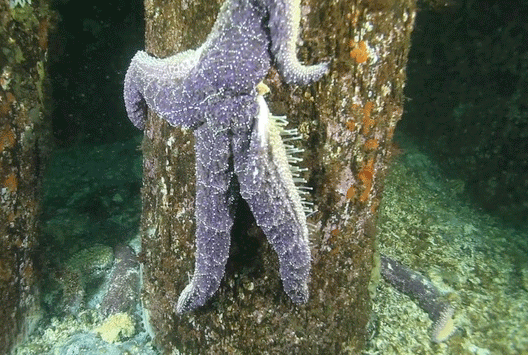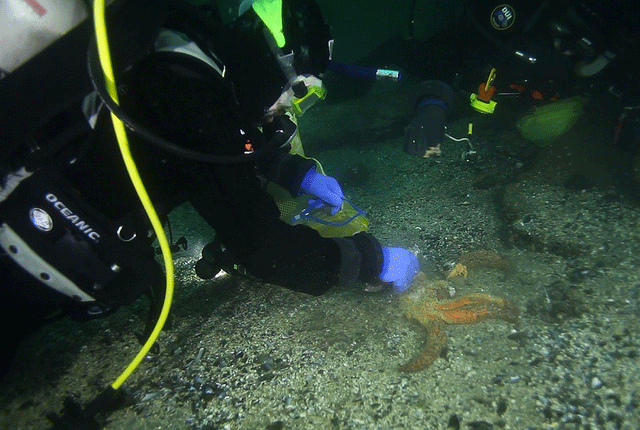Sea Star Mystery
Air Date: Week of April 11, 2014

Two sea stars share a tank, one is healthy and the other is dying. (Katie Campbell)
A mysterious malady is infecting many species of starfish up and down the US west coast. It causes lesions and the sea stars rip themselves apart. Katie Campbell reports on the biologists down at the shore trying to unravel what's going on.
Transcript
CURWOOD: Since last summer, starfish have been dying at a rate that scientists have never seen before; a strange disease is causing them to literally rip themselves apart. It started with the Sunflower Sea Star, but it's spread to nearly a dozen species up and down the west coast of the US, and kills about 95 percent of the animals affected. Marine biologists are perplexed. Katie Campbell of the public media collaborative EarthFix has been following the researchers work and has our report.
[SEAGULLS, DIVERS HAULING EQUIPMENT TO THE WATER, CHECKING THEIR BREATHERS]
CAMPBELL: It’s a chilly gray morning at the Mukilteo ferry docks, just north of Seattle. A group of scientists and volunteer divers shimmy into suits and double-check their air tanks. They move with the urgency of a group on a mission. And they are. They’re trying to solve a marine mystery. Starfish, or sea stars as scientists like to call them, are dying here and nobody knows why. And it’s not just happening in Puget Sound. Sea stars are wasting away by the tens of thousands up and down North America’s Pacific shores.

A dying Pisaster ochraceus sea star in the waters off Seattle dangles by its tentacles off an underwater piling that would normally be covered with a rainbow of sea stars. (Laura James)
MINER: We’re here today at the Mukilteo docks to collect some sick and healthy sea stars for an infectiousness experiment that I hope to start this afternoon.
CAMPBELL: That’s Ben Miner. He’s a biologist who’s leading this mission. Miner is a professor at Western Washington University. He studies how environmental changes affect marine life.
[DIVERS WALKING INTO WATER, BREATHING USING THEIR AIR TANKS]
CAMPBELL: One by one the divers sink beneath the surface. Normally this place is brimming with life, a favorite hangout for starfish. But the divers discover a deadly scene.
MINER: On the pilings there were healthy sea stars but we were also coming across arms and piles of deteriorated sea stars. So you just see piles of goo all over the place.
CAMPBELL: Scientists first started noticing sick and dying starfish last summer on Washington’s Olympic Peninsula. They coined it "Sea Star Wasting Syndrome” because of how quickly the stars disintegrate. Reports have since surfaced from Alaska to Southern California. About a dozen species of sea stars are dying, and that raises an important question. Scientists wonder if this is an indicator of a larger problem.
MINER: It certainly suggests that those ecosystems are not healthy.
CAMPBELL: Some have suggested that radiation from Japan’s Fukushima nuclear disaster could be the culprit. But scientists say that’s unlikely because the die-offs aren’t happening in one big wave. They’re patchy. It’s popped up in places like Seattle and Santa Barbara, and not in others, such as coastal Oregon, where wasting has only been reported at one location. Just 80 miles from Mukilteo, on San Juan Island, Drew Harvell hasn’t seen any signs of sick starfish.
HARVELL: We’re still holding steady here and we don’t know why. Honestly, sometimes the more I see, the more interesting or perplexing it becomes,
CAMPBELL: Harvell is collecting tissue samples from a healthy sunflower star.
[WATER DRIPPING. HARVELL CUTTING UP STARFISH IN THE LAB.]

Ben Miner collects arms of dying starfish for lab analysis. (Laura James)
HARVELL: This is a healthy Pyncapodia with no signs of lesions.
CAMPBELL: Harvell is a marine epidemiologist from Cornell University. She’s coordinating coast-to-coast research into the starfish epidemic from the University of Washington’s Friday Harbor labs. She’ll send these samples to a lab at Cornell. There they will be compared against sick starfish and analyzed for viruses as well as bacteria and other protozoa.
HARVELL: We know that all organisms get sick, they get bacteria, they get viruses just like humans do. They get the cold and the sniffles, but it’s a lot harder to see it happening when they are under the ocean.
CAMPBELL: The first step, she says, is to figure out the exact fingerprint of the disease. And how it’s moving from place to place.
[MINER’S TEAM COMING ASHORE]
CAMPBELL: Back in Mulikteo, Miner’s team collected about 20 fat, multi-armed stars. Some appeared healthy. Others had lesions and twisted arms.
[TRUCK DOOR CLOSING]
CAMPBELL: Miner trucked the stars to an aquarium-filled lab in Anacortes. He placed one sickly star in with one healthy-looking star. He also set up tanks containing only healthy-looking stars for comparison. Then he waited to see what would happen.
MINER: One of them was very sick and the other two started ripping themselves apart. The arms just crawl away from the particular body.
CAMPBELL: You heard that right. The arms crawled in opposite directions until they tore away from the body. Starfish have the ability to lose their arms as a form of defense. But these starfish were too sick to regenerate their arms. Their insides spilled out. And they died within 24 hours. But surprisingly, their healthy looking neighbors didn’t show symptoms any more rapidly. So being in the same tank with a dying starfish doesn’t seem to accelerate the disease. It’s clues like this that are helping scientists hone in on the cause. They’re starting new experiments to test possible infectious agents and they hope to make an announcement in the coming months.
In Mukilteo, I’m Katie Campbell reporting.
CURWOOD: There's more at our website, LOE.org, including details of how you can use a Smartphone to report sightings of sickly sea stars to help the biologists.
Links
Living on Earth wants to hear from you!
Living on Earth
62 Calef Highway, Suite 212
Lee, NH 03861
Telephone: 617-287-4121
E-mail: comments@loe.org
Newsletter [Click here]
Donate to Living on Earth!
Living on Earth is an independent media program and relies entirely on contributions from listeners and institutions supporting public service. Please donate now to preserve an independent environmental voice.
NewsletterLiving on Earth offers a weekly delivery of the show's rundown to your mailbox. Sign up for our newsletter today!
 Sailors For The Sea: Be the change you want to sea.
Sailors For The Sea: Be the change you want to sea.
 The Grantham Foundation for the Protection of the Environment: Committed to protecting and improving the health of the global environment.
The Grantham Foundation for the Protection of the Environment: Committed to protecting and improving the health of the global environment.
 Contribute to Living on Earth and receive, as our gift to you, an archival print of one of Mark Seth Lender's extraordinary wildlife photographs. Follow the link to see Mark's current collection of photographs.
Contribute to Living on Earth and receive, as our gift to you, an archival print of one of Mark Seth Lender's extraordinary wildlife photographs. Follow the link to see Mark's current collection of photographs.
 Buy a signed copy of Mark Seth Lender's book Smeagull the Seagull & support Living on Earth
Buy a signed copy of Mark Seth Lender's book Smeagull the Seagull & support Living on Earth

